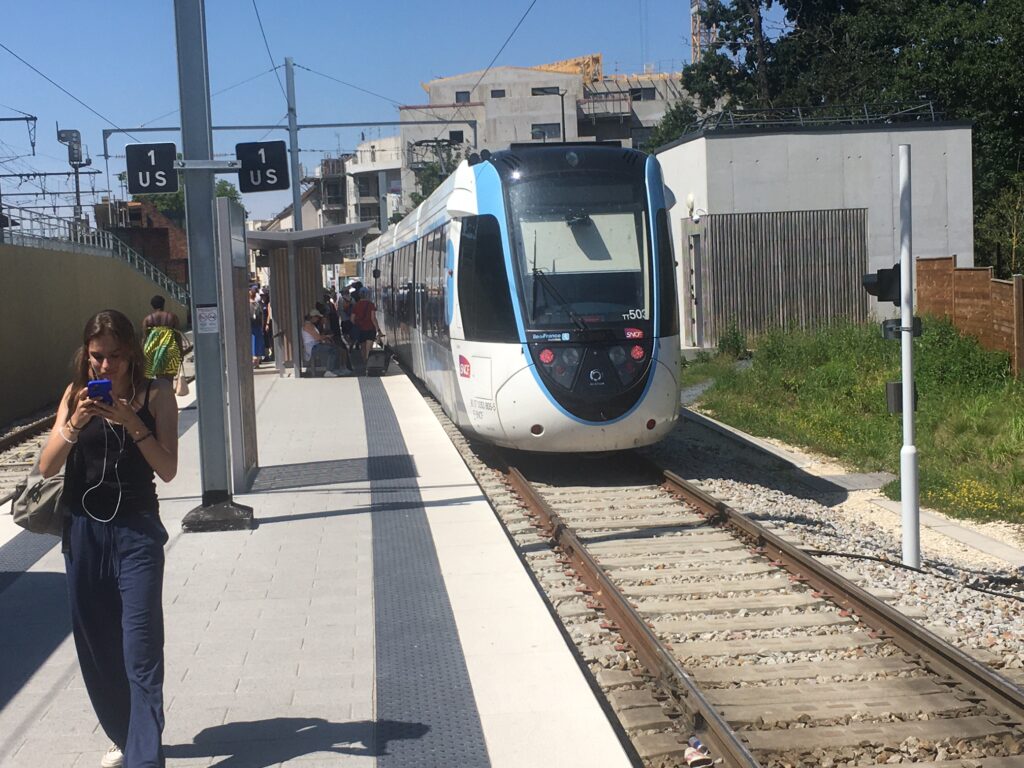Good transportation is always the key to a successful Olympic Games, and Paris has overall scored highly.
Generally, it is relatively easy to get to venues, though some of those in outlying areas present more of a challenge.
The Metro is amazing once you have figured out the labyrinth of lines and you can speedily get from place to place.
Trains run with a frequency that is jaw-dropping, though one Parisienne observed ‘it is not like this all the time’. They are operating early in the morning and into the wee small hours and still regularly.

The tram stop at Saint-Cyr
I find it far quicker to cross Paris than London whose underground seems positively antiquated compared to the Metro.
The Metro also dovetails well with the RER network, and you are seldom waiting any length of time for connections.
Metro and RER stations have plenty of clear signage which helps with navigation and there are signs signalling which competition venue to alight.
There are also tannoy announcements, both on the trains and on the stations while there are volunteers at nearly every station to help guide visitors.
On a personal note, I have spent seven days at Versailles for equestrian events which has been challenging as my hotel is in the east of Paris and that venue is south-west.
It requires using two Metro lines, RER Line C and a shuttle bus to the grounds of the Palace of Versailles then a walk of nearly a mile to the grandstand for the equestrian events.
That takes one-and-three-quarter hours on a good day and three hours on a bad one.
The media were advised to take public transport as it was quicker but, arriving early one morning having arranged interviews, I discovered I was too early for the shuttle buses and had a 45-minute wait.
They also cease at 6pm and, with copy to file, that means finding another route back, using a tram from Allee Royales to Saint-Cyr and then catching a mainline SNCF service.
I ended up taking a different route back into Paris on my first three days – including taking a wrong train and heading away from the capital – before finally mastering it. Once you know what to do, it is straightforward, but not when unfamiliar.
As the media’s transportation hub is in the west of Paris and I am based in the right, I have tended to find using public transport more convenient unless heading out of the city to places like the velodrome where using public transport was more challenging.
By and large, though, the transport system has worked well which is generally the case at Olympics with the exception of 1996 in Atlanta, the second of my eight summer Olympics, which was shambolic.
Barcelona in 1992, my Olympics debut, was also not without its issues. I had an official package with a travel company which entailed staying in Lloret de Mar and commuting in daily which was a nightmare, especially late at night when services ceased. Hundreds of visitors were left stranded and the travel company had to find replacement buses/coaches to take us from Blanes back to Lloret.
Los Angeles in 2028 will also be a challenge if my intelligence proves right.
I have spoken to a LA-based broadcaster who mentioned worryingly that her city does not have a transport system, and it is something they are working to resolve.
This was confirmed by another US journalist who pointed out everybody owns a car and not many use public transport.
That is something LA’s organising committee will have to resolve because hundreds of thousands of visitors will descend on the city, and they will need means of moving between venues and a transport system which is fit for purpose